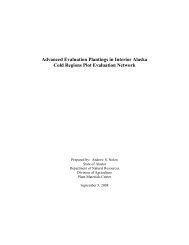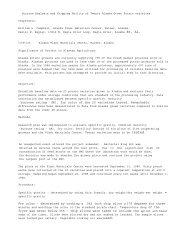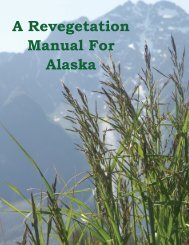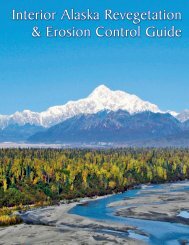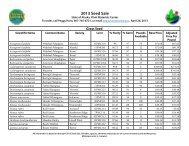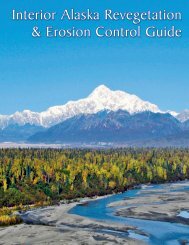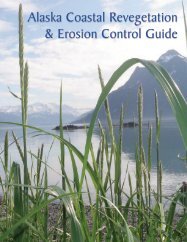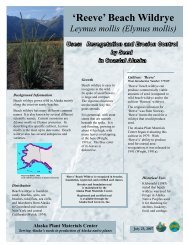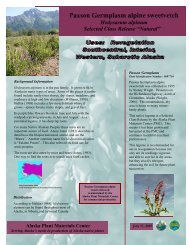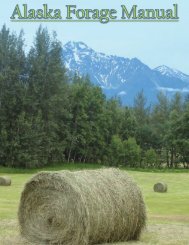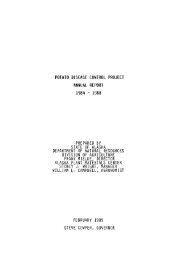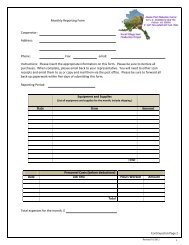Alaska Forage Manual - Alaska Plant Materials Center - State of ...
Alaska Forage Manual - Alaska Plant Materials Center - State of ...
Alaska Forage Manual - Alaska Plant Materials Center - State of ...
Create successful ePaper yourself
Turn your PDF publications into a flip-book with our unique Google optimized e-Paper software.
Term<br />
Lanceolate:<br />
Lemma:<br />
Lignin:<br />
Lodging:<br />
Meadow:<br />
Metabolic Energy:<br />
Definition<br />
Much longer than wide, widest below the middle and tapering toward both ends, sometimes<br />
rounded at the base.<br />
Lower bract <strong>of</strong> the grass floret, placed above the glumes with its back toward the outside <strong>of</strong> the<br />
spikelet or away from the rachilla.<br />
Complex non-carbohydrate strengthening material in the thickened cell walls <strong>of</strong> plants;<br />
practically indigestible.<br />
Collapse <strong>of</strong> top heavy plants, particularly grain crops, due to excessive growth or pressure from<br />
wind and rain.<br />
An area <strong>of</strong> perennial herbaceous vegetation, usually grasses or grass like, used primarily for hay<br />
production.<br />
Food intake gross energy minus fecal energy, minus energy in the gaseous products <strong>of</strong> digestion,<br />
minus urinary energy.<br />
Monoculture:<br />
Native <strong>Plant</strong> / Species:<br />
Cultivation <strong>of</strong> a single species to the exclusion <strong>of</strong> other potential crops.<br />
A plant that occurs naturally in a particular region, state, ecosystem, and habitat without direct<br />
or indirect human actions. Climate, soil, and biotic factors determine its presence and evolution<br />
in an area.<br />
Net Energy (NE): Calculated from ADF. Net energy estimates are used largely by dairy producers in ration balancing<br />
for maintenance (NEm), gain (NEg), and lactation (NEl).<br />
Neutral Detergent<br />
Fiber (NDF):<br />
An estimate <strong>of</strong> the portion <strong>of</strong> a forage sample that is in the walls <strong>of</strong> a plant cell. It is measured<br />
by boiling a forage sample in a neutral detergent and weighing the residue. Boiling removes the<br />
soluble components <strong>of</strong> the cell - most <strong>of</strong> the sugars, fats, starches, and proteins. The remaining<br />
residue is composed <strong>of</strong> cell walls made up <strong>of</strong> cellulose, hemicellulose, and lignin. The amount <strong>of</strong><br />
NDF residue is inversely related to forage intake. High quality forages have low amounts <strong>of</strong> NDF.<br />
Nitrate Poisoning:<br />
Node:<br />
Oblique:<br />
Condition sometimes resulting when ruminants ingest nitrates (NO3). The rumen bacteria<br />
convert to nitrite (NO2); the nitrites compete with oxygen, tying up the oxygen-carrying<br />
mechanism in the blood and causing the animal to suffocate.<br />
Joint on a stem, represented by position <strong>of</strong> origin <strong>of</strong> a leaf or bud<br />
Lop-sided, one side <strong>of</strong> leaf base is larger, wider or more rounded than the other.<br />
Oblong: Two to four times longer than broad.<br />
Obovate: Inversely ovate, attached at the narrow end.<br />
Obovoid: Leaf shape that is inversely egg-shaped or ovoid.<br />
Obtuse: Blunt or rounded at the tip, with sides coming together at an angle greater than 90 °.<br />
Oval:<br />
Ovate:<br />
Ovoid:<br />
Palatability:<br />
Twice as long as broad, widest at the middle, both ends rounded.<br />
Egg shaped in outline, narrower at the tip and attached at the larger end. Applies to flat surfaces.<br />
Egg shaped; Applies to three-dimensional structures.<br />
The relish with which a particular species or plant part is consumed by an animal.<br />
Palea:<br />
Palmate:<br />
Upper bract <strong>of</strong> the floret, placed above the lemma with its back toward the rachilla.<br />
With three or more lobes, veins or leaflets arising from one point, <strong>of</strong>ten five to seven.<br />
Pasture: Grazing land comprised <strong>of</strong> introduced or domesticated native forage species that are used<br />
primarily for the production <strong>of</strong> livestock. These lands receive periodic renovation and/or cultural<br />
treatment (such as tillage, fertilization, mowing, weed control), and may be irrigated.<br />
Perennials: <strong>Plant</strong>s that normally live for more than two years.<br />
Petiole:<br />
The stalk that joins a leaf to stem; (leaf stalk).<br />
Petiolule:<br />
pH:<br />
Pilose:<br />
The stalk <strong>of</strong> a leaflet <strong>of</strong> a compound leaf.<br />
A measure <strong>of</strong> the hydrogen-ion concentration in a solution, expressed on a negative log 10 scale<br />
<strong>of</strong> 0 (highly acidic) to 14 (highly basic) with pH <strong>of</strong> 7 being neutral. See charts on page 23.<br />
Long s<strong>of</strong>t hairs.<br />
105



